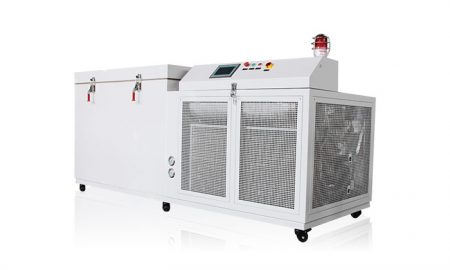Bearing Freezer Refrigeration
Kontaktieren Sie uns noch heute für die perfekte Lösung zur Temperaturkontrolle
The principle of bearing freezer refrigeration
When assembling bearings, the tolerance between the outer diameter of the bearing and the bore of the shaft seat is often too large, which increases the difficulty of assembly and even causes damage to the bearing. In order to solve this problem, the method of cooling the bearing can be used to shrink the outer diameter of the bearing, thereby making the bearing assembly easier.
Bearing freezer refrigeration method
The method of bearing freezer refrigeration is to place the bearing in a refrigerator or a special freezing device for freezing treatment, so that the surface temperature is reduced to about -30°C ~ -40°C. Normally, the inner diameter of the bearing will shrink slightly, while the outer diameter of the bearing will shrink significantly. For bearings with larger outer diameters, the shrinkage rate can reach more than 0.1%.

Precautions for bearing freezer refrigeration
1. Before the bearing is frozen and assembled, the oil on the surface of the bearing needs to be cleaned first to prevent the formation of ice crystals from causing damage to the bearing surface.
2. When the bearing is frozen and assembled, the bearing needs to be taken out of the cooling device and assembled immediately to avoid dripping water and ice crystal residue on the bearing surface from increasing damage to the bearing surface.
3. After the bearing is frozen and assembled, you need to wait for the bearing to return to room temperature before adding lubricating oil.
In short, using the freezing assembly method of bearings can effectively improve the accuracy and efficiency of assembly and avoid bearing damage. When freezing bearings for assembly, the above precautions need to be noted to avoid damage to the bearing surface and a decrease in assembly quality.
E-Mail: info@lneya.com WeChat ID: +8615251628237 WhatsApp: +86 17851209193

Industrielle Gefriergeräte
Geeignet für die Prüfung verschiedener Materialien bei extrem niedrigen Temperaturen, die Prüfung der Kaltschrumpfung von Kupferhülsen und Lagern usw.
| Temperaturbereich | Serie -65°C ~ -10°C | Serie -80°C ~ -10°C | Serie -100°C ~ -30°C | Serie -150°C ~ -20°C | |||||
| Band | bis zu 1600L | bis zu 1600L | bis zu 1600L | bis zu 1000L | |||||
| Hinweis: Jeder Temperaturbereich von -150℃ ~ +350℃ und jede Kühlleistung kann angepasst werden | |||||||||
 LNEYA
LNEYA
 简体中文
简体中文


















































































